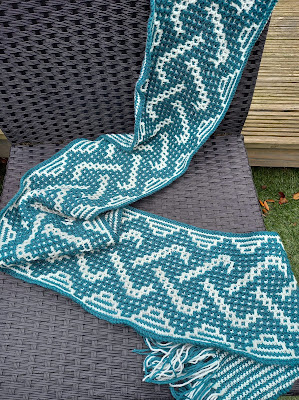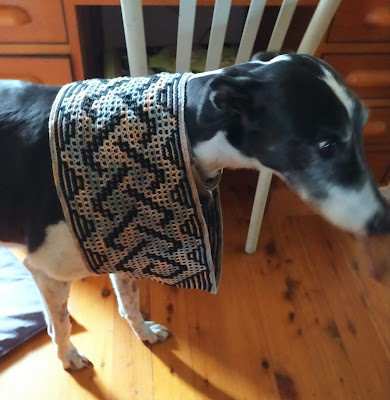Hello to blog readers old and new! I'm so happy to tell you my design was voted to be shown eighth (out of a total of 26 submitted) by the readers of CAL - Crochet A Long Facebook Group CLICK HERE to visit, and today is the day I get to show it off to you!
As promised - for a short time - the pattern is available to be downloaded for free. This link to it will expire on 23 November so click HERE to download my Braided Little Squares Scarf pattern without delay!
It's written in UK terms, uses the overlay mosaic crochet technique and has photos showing how to construct the special stitches needed and the fringe. A chart is provided for those who prefer to crochet from them.
The pattern has been thoroughly tested by a super group of volunteers. I was particularly pleased that three of my testers Susan, Mum and Shazia had never worked on an overlay mosaic crochet pattern before so it was great that they all managed to produce beautiful scarves as you can see below.
I've used Stylecraft Highland Heathers for mine, this is a Double Knitting weight yarn but my testers used lots of different yarns (detailed below).
After the 23 November, the pattern will be available for a modest fee in my Etsy shop click HERE in UK terms. At that time, a US version will also be available.
The design works well with solid colours as well as self-striping yarns with longer lengths. Variegated yarns (like those used for fair isle effect or having short colour changes) should be avoided for this design.
Extra special thanks to Laurene Leeseberg Bluder and Silke Karp who were always available with help on the administration and overall organisation of the whole event. This design wouldn't exist without them. They work awfully hard in the background.
I leave you with photographs from my wonderful testers in no particular order other than how they arrived in my inbox. They said some lovely things about the pattern, which modesty forbids me to repeat here, but you can read what they had to say about the design on the CAL - Crochet A Long blog posting, click HERE.
Susan Powell
Used Crafty DK in Deep Lake and Cream purchased from Aldi. Strong contrasts work so well in Susan's gorgeous scarf.
Elaine Tuttle Shrock
Used 6 oz of Premier Anti Pilling DK in Meadow, 4.5 oz of Loops & Threads Joy DK in Snow. What an elegant scarf Elaine has created!
Karen Dixon
Used Cygnet DK, a truly gorgeous combination of Candyfloss and Chiffon. I just love pink and grey together!
Tammy Alexander, unfortunately unable to finish her scarf due to circumstances outside her control but she made some fantastic observations on the pattern which will benefit everyone using the pattern in the future so she deserves big thanks and credit for her contribution.
Jamie Storer
Used Lion Brand Wool-Ease in Bedazzles and part of a Mega Ball DK from Hobbii in black. I think this yarn was made for this design, Jamie's scarf is so striking.
Anya Roche
Used Nani’s Yarns 4 ply Mulberry Silk in colourways Peach to soft
green, and 3-ply Merino silk in Black. As these yarns are thinner than DK
recommended in the pattern, she went down to a 3.25mm hook.
Anya had her friend, Aleashia, model her creation. Very cleverly, she used fewer repeats and joined it in the round to make this wonderful cowl.
It was a little bit big for Barry, the dog :-) Awwww, isn't he beautful though?
Malathi Seshandra
Used Premier Luna and Cascade yarn. Another self-striping yarn used to great effect in Malathi's scarf.
Mum Taylor
Used Stylecraft Special DK in Teal and White, great contrast here again with bold colour blocks
Shazia Suhail
Sunshine colours will cheer up the greyest of winter days, a bright and fun combination.
Thanks again to all my testers for taking part in this, and the administrators behind the Facebook Group, it was a wonderful experience working with you all! The whole experience has been an utter joy.



























































